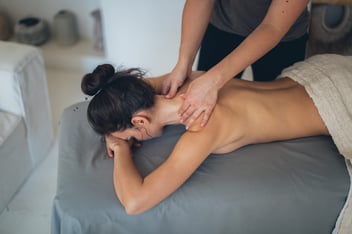 Most people think they know how to avoid a back injury when lifting things. They are in total disbelief when they are injured after performing an “easy” lift. After sustaining an injury, they may even say, “but I bent at the knees too!” Although it is true that we need to bend at our knees when lifting materials, there is more preventive measures we need to take.
Most people think they know how to avoid a back injury when lifting things. They are in total disbelief when they are injured after performing an “easy” lift. After sustaining an injury, they may even say, “but I bent at the knees too!” Although it is true that we need to bend at our knees when lifting materials, there is more preventive measures we need to take.
Muscular Injury
Returning to your original position when lifting things puts stress on the muscles of your lower back. When the stress is excessive, it results in an injury. This type of injury is called muscle strain and is quite painful. After sustaining a muscular injury, it can be difficult to move normally due to pain. Back strains usually heal on their own, although it can take several weeks or months. A physiotherapy treatment can help speed up the recovery process.
Intradiscal Injury
Injury to discs occur when there is too much force or stress placed upon them. These discs act as tiny cushions in our spines. When injured, pain will be felt at the area of injury and down the legs and in the buttocks.
Joint Injury
Joints are the bones that meet at points in our backs. Usually, they are able to withstand heavy-duty wear and tear, but there are occasions when the stress is too much. The end result is a "locking" of the joint and the inability to stand or walk properly.
Avoiding Injury
In addition to bending at the knees when lifting, there are other preventive measures necessary to avoid back injuries:
Keeping the weight close to your body. When an object is not close to our bodies, the pull of gravity makes it harder to lift. Having the object as close as possible lessens stress put on the lower back.
Maintain shoulder alignment with your hips. Often times, people tend to lead with their shoulders when lifting, and the end result is a twisting injury. Make sure to keep both hips and shoulders in unison to avoid a torsion injury.
Chest forward. Although bending at the knees is important, it doesn't completely prevent back injuries. When lifting, be sure to bend at the hips and push your chest forward. In turn, your knees and legs with automatically coincide with the proper lifting technique to prevent you from unnecessary back injuries.
As with any type of heavy lifting, never attempt to lift objects heavier than you can truly manage. Even the strongest of people have a lifting limit, and crossing that threshold can result in a painful back injury.
If you got injured while handling material, talk to our physiotherapists today. Call us at 905-232-2202 or book an appointment online.


